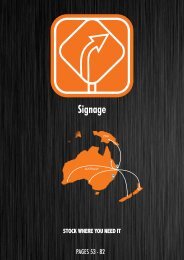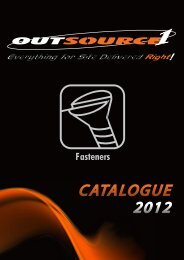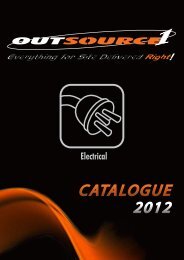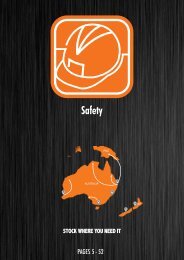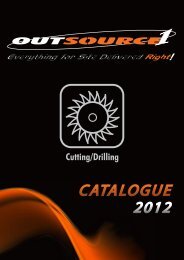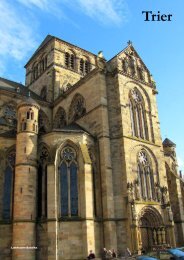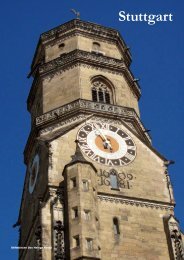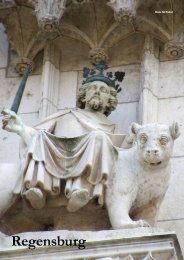Raven Guides: Germany - Wurzburg
- No tags were found...
Create successful ePaper yourself
Turn your PDF publications into a flip-book with our unique Google optimized e-Paper software.
Würzburg<br />
Frankoniabrunnen
The prime view of Würzburg’s Altstadt is from the<br />
Fürstengarten in front of Festung Marienberg.<br />
Würzburg<br />
For hundreds of years church<br />
and state were one in Würzburg<br />
and the city’s main landmarks,<br />
including one of Europe’s<br />
magnificent palaces, are<br />
monuments to this link.<br />
Würzburg’s ecclesiastical and secular power<br />
combined in the person of the prince-bishop.<br />
The Würzburg bishopric goes back to the mid<br />
8th century but princely status under the Holy<br />
Roman empire was conferred in the mid 12th<br />
century and a ducal title was added in the mid<br />
15th century. Würzburg was briefly a grand<br />
duchy until 1814.<br />
The prince-bishops’ power ended with<br />
Napoleon’s policy of secularising the German<br />
states, but they were at the peak of their<br />
influence in the 17th and 18th centuries. This<br />
period was ushered in by the long episcopate<br />
of Julius Echter von Mespelbrunn, founder<br />
of the Juliusspital, refounder of Würzburg’s<br />
university in 1582 and rebuilder of the<br />
powerful fortress on Marienberg, perched on<br />
the opposite bank and dominating the city.<br />
Echter’s firm hand left its mark in many other<br />
ways over more than 40 years in office.<br />
Under the Schönborn bishops the magnificent<br />
Residenz was commissioned and<br />
built. This Baroque palace with almost 400<br />
rooms is recognised with UNESCO world<br />
heritage listing as one of the world’s great<br />
buildings. The chief architect and engineer<br />
was Balthasar Neumann, who died and mostly<br />
lived in Würzburg, spending more than 20<br />
years supervising the building. The adjacent<br />
Hofgarten and square are also listed.<br />
The Residenz took over from the castle as<br />
the seat of the bishops. The bodies of most of the<br />
Würzburg bishops are buried in the cathedral,<br />
but for hundreds of years their entrails were<br />
interred in the castle’s Marienkirche and their<br />
hearts went to the Ebrach abbey between<br />
Würzburg and Bamberg.<br />
The cathedral was dedicated to St Kilian,<br />
the apostle of Franconia, who brought<br />
Christianity to the region from Ireland late in<br />
the 7th century and was martyred with two<br />
RAVEN QUICK GUIDE<br />
Tourist information & accommodation service: Marktplatz 9 (tel 0931-372335, Jan-Mar<br />
M-F 10-16, Sa 10-14, Apr & Nov-Dec M-F 10-18, Sa 10-14, May-Jul M-F 10-18, Sa 10-15,<br />
Su 10-14, Aug-Oct M-F 10-18, Sa 10-15).<br />
Money: Deutsche Bank, Juliuspromenade 66 (M & Th 9-13, 14-18, Tu-W & F 9-13,<br />
14-17); HypoVereinsbank, Eichhornstraße 1 (M-W & F 9-16, Th 9-17); Commerzbank,<br />
Beim Grafeneckart 11 (M, W & F 9-16, Tu & Th 9-18).<br />
Lockers: Hauptbahnhof passage (€5/3 per day).<br />
Transit information: WVV, Haugerring 5 (M-F 8-16.30); WVV Kundenzentrum,<br />
Domstraße 26 (M-F 9-19, Sa 9-16).<br />
Post: Bahnhofplatz 2 (M-F 8.30-18, Sa 9-12); Marktplatz 20 (M-F 9.30-19, Sa 9.30-17);<br />
Paradeplatz 4 (M-F 8.30-18, Sa 9-12).<br />
Internet: Stadtbücherei, Falkenhaus, Marktplatz 9 (M-W & F 10-18, Th 10-19, Sa 10-15).<br />
Laundry: SB-Waschsalon, Annastraße 13A (M-Su 6-22); Waschhaus, Frankfurter Straße<br />
13A (M-Sa 7-22, Su 9-18).<br />
Police: tel 110; Nürnberger Straße 37 (tel 0931-4570).<br />
Pharmacy: City-Apotheke, Haugerpfarrgasse 1 (M-F 7.30-19, Sa 8.30-15.30);<br />
Engel-Apotheke, Marktplatz 36 (M-F 8.30-18.30, Sa 9-18); Echter Apotheke,<br />
Echter-Galerie, Juliuspromenade (M-F 8-19, Sa 9-16).<br />
Ambulance: tel 112.<br />
Hospital: Stiftung Juliusspital, Juliuspromenade 19 (tel 0931-3930); Universitätsklinik<br />
Würzburg, Josef-Schneider-Straße 2 (tel 0931-2010).<br />
missionaries near the present cathedral. They<br />
appear among the Baroque statues on the Alte<br />
Mainbrücke leading across the Main from the<br />
Altstadt.<br />
Most of the great building projects and<br />
foundations of Würzburg are due to the<br />
influence and patronage of the prince-bishops<br />
and from medieval times this ecclesiastical<br />
indulgence provided opportunities for<br />
artists. The prime example is the peerless<br />
© 2014 RAVEN TRAVEL GUIDES GERMANY<br />
RAVEN TRAVEL GUIDES GERMANY - Würzburg 1
The Residenz was the<br />
ultimate statement of the<br />
Schönborn prince-bishops<br />
of the early 18th century,<br />
who engaged leading<br />
architects as consultants<br />
but placed responsibility<br />
for the project in the hands<br />
of Balthasar Neumann.<br />
Construction lasted from<br />
1720 to 1744 under three<br />
bishops but the interior<br />
decoration took much<br />
longer. Lord Clark<br />
described the palace as<br />
“about three times the<br />
size of Buckingham Palace and incomparably more splendid”. It is an overwhelming<br />
feast of features, the high point being the staircase and its huge unsupported ceiling with a<br />
stuccoed fresco by Giovanni Battista Tiepolo, depicting four continents in homage to the<br />
bishops and a host of other stories and personalities, including Neumann in artillery<br />
uniform. The breathtaking Kaisersaal, designed for imperial visits and suitably<br />
elaborated by Tiepolo, the Gartensaal, the Hofkirche and Weißer Saal are all sumptuous<br />
and the apartments are a riot of interior painting, tapestry and furniture by Italian, French<br />
and German artists. It is hard to imagine that parts were severely damaged by World<br />
War II bombing. Admission to the palace (Apr-Oct M-Su 9-18, Nov-Mar M-Su 10-16.30)<br />
costs €7.50/6.50 (visitors under 18 admitted free). The 50-minute guided tours in English<br />
(Apr-Oct M-Su 11.00, 15.00 and 16.30, Nov-Mar M-Su 11.00 and 15.00) are included, the<br />
best way to appreciate the palace and well worth the experience. The south wing houses<br />
the Martin von Wagner Museum (see Museums & Galleries).<br />
The first Würzburg cathedral was consecrated in 788 in the<br />
presence of Charlemagne. A 9th century church built for<br />
the bishop St Arno stood on the site and the founder of the<br />
11th century church was the bishop St Bruno. The present<br />
Romanesque Dom St Kilian (M-Sa 10-17, Su 13-18) at<br />
Domplatz was consecrated in the 12th century. The tombs<br />
of bishops over 700 years are among the nave pillars. Two<br />
effigies, of Rudolf von Scherenberg and Lorenz von Bibra,<br />
are by Tilman Riemenschneider, who also sculpted Christ<br />
with two apostles. In the 18th century a Baroque stucco<br />
interior was created by Pietro Magno and an ornate chapel<br />
to the Schönborn bishops on the north of the transept was<br />
built by Neumann and Maximilian von Welsch. Much is<br />
rebuilt or restored from World War II damage.<br />
Included in the palace’s heritage listing is the<br />
Hofgarten (M-Su 9-20 or sunset, entry free),<br />
created by Johann Prokop Mayer for bishop<br />
Adam von Seinsheim after the palace’s<br />
decoration was finally complete in the 1770s.<br />
Its Rococo forms are in keeping with the<br />
earlier palace and are in part designed to<br />
conceal the defences of the later period that<br />
surround the city. The main eastern and<br />
southern gardens are separately designed and<br />
there is a kitchen garden and orangery. The<br />
early Classical garden statues were sculpted by<br />
Johann Peter Wagner.<br />
The 13th century church Neumünster was built on the<br />
site of the 7th century martyrdom of St Kilian and two<br />
missionaries. Johann Greising’s dome and the ornate<br />
18th century facade by Johann Dientzenhofer contrast<br />
with the spare exterior of the adjacent Dom. Much of<br />
the ceiling frescoes and stucco work is rescued from<br />
bombing damage, although not all the features of the<br />
church could be salvaged or restored. Most of the<br />
remains of St Kilian and his companions are in an altar<br />
(the skulls are in the cathedral). The Lusam Gartlein<br />
with a surviving Romanesque cloister can be entered<br />
from the north side of the church or Martinstraße and<br />
is celebrated as the resting place of the medieval poet<br />
Walther von der Vogelweide.<br />
sculpture of the Würzburg resident Tilman<br />
Riemenschneider, whose work in Franconia<br />
and Swabia gained him both wealth and<br />
reputation at a time when the souls of men<br />
were torn over concepts of piety. He became<br />
the foremost practitioner in limewood carving<br />
and his place as a leader in the German<br />
transition from Gothic to Renaissance puts him<br />
alongside the painting and drawing of Dürer.<br />
His work for the church is represented in the<br />
Mainfränkisches Museum in the Marienberg<br />
castle, notably the carvings of Adam and Eve<br />
and of Mary, and in the city’s churches, chiefly<br />
the cathedral. Yet much of his early work in<br />
Würzburg was secular and his social position<br />
eventually made him mayor of Würzburg.<br />
But Riemenschneider became ensnared by<br />
this web of religion and politics. In 1525, after<br />
the Reformation had arrived, the peasants’<br />
revolt – which was rejected by Luther – made<br />
its way towards Würzburg. The city council<br />
made common cause with the peasants, whose<br />
forces were smashed by the Würzburg bishop<br />
Konrad von Thüngen. Riemenschneider was<br />
jailed and tortured before being released, but<br />
his great works were at an end.<br />
A contemporary of Riemenschneider also<br />
claimed by Würzburg is the mysterious genius<br />
Matthias Grünewald, who is represented on<br />
the fountain Frankoniabrunnen outside the<br />
Residenz. The painter, of whose works few<br />
have survived, had a wide reputation in his<br />
time but the references to his Würzburg origin<br />
are suspect.<br />
Wine has had a long history in the region<br />
and vineyards cover the slopes around the<br />
city. Some of the historic cellars are easily<br />
visited and there is an annual wine festival<br />
to celebrate. But wine also financed the<br />
Juliusspital, drawing on revenue from the<br />
bishops’ vineyards and the cellars, some of the<br />
largest in <strong>Germany</strong> and still in use.<br />
Few figures have equalled the impact<br />
on medical science of the physicist<br />
Wilhelm Röntgen. Röntgen discovered the<br />
electromagnetic potential of what are now<br />
known as X-rays while holding the physics<br />
chair at Würzburg, one of the oldest-German<br />
speaking universities. His proposal for using<br />
them for diagnostic imaging won him the first<br />
Nobel Prize in physics. His laboratory and<br />
equipment are now featured in a museum.<br />
Altstadt<br />
A walk through the old town should start at<br />
the Residenz. Hofstraße leads directly away<br />
from the forecourt toward the back of the<br />
cathedral. Turn south-west at Paradeplatz and<br />
use this and Am Bruderhof to circle around<br />
to the cathedral’s main door. Domstraße<br />
leads due west past the Rathaus and its tower<br />
Grafeneckart on the right to the medieval<br />
bridge Alte Mainbrücke, opposite the Marienberg<br />
and its castle.<br />
Turn north to walk parallel with the Main’s<br />
east bank along Karmelitenstraße and turn<br />
right behind the Rathaus on Rückermainstraße<br />
to enter Marktplatz, walking straight ahead<br />
with the Marienkapelle and the ornate facade<br />
of the Falkenhaus (with tourist information)<br />
on the left. Still in a pedestrian zone, turn<br />
north on Schönbornstraße, then right on<br />
Juliuspromenade to walk past the Juliusspital.<br />
A left turn at Kaiserstraße leads to the<br />
Hauptbahnhof or a right turn back to the<br />
Residenz.<br />
RAVEN TRAVEL GUIDES GERMANY - Würzburg 2
Würzburg’s oldest secular building is the Romanesque<br />
tower of the Rathaus, known as Grafeneckart, which with<br />
the vaulted Gothic Wenzelsaal is 13th century. The red<br />
sandstone Rote Bau is a Renaissance addition on the north<br />
side. In the room by the main portal is a memorial of the<br />
1945 raid that wrecked the city and the Würzburg model is<br />
worth comparing with today’s view from the Marienberg.<br />
The tree painted on the facade in the 16th century is said to<br />
depict an earlier public meeting place. The 90-minute free<br />
tours (May-Oct Sa 11.00) are in German only. The<br />
Vierröhren fountain (1766) opposite, dominated by a<br />
female Frankonia, is by Lukas van der Auvera and Johann<br />
Peter Wagner.<br />
The Main river traffic was vital and<br />
the powerful Alter Kranen (1773, by<br />
Balthasar Neumann’s son Franz) at<br />
the end of Juliuspromenade was the<br />
centre of harbour operations. It was<br />
not the first crane at the site but<br />
survives almost complete. Either<br />
boom was capable of lifting a ton or<br />
more (the inscription proudly claims<br />
it can handle and dispatch any load).<br />
The mighty wooden treadwheel is<br />
visible inside the vaulted structure<br />
and required two men to operate.<br />
The soaring towers at the end of Bahnhofstraße mark<br />
the cruciform Baroque parish church of St Johannes<br />
Stift Haug (1691), built by Antonio Petrini. The<br />
foundation once stood near the Hauptbahnhof site with<br />
an 11th century church (ransacked by Swedish forces<br />
during the Thirty Years War) but had to be moved when<br />
the city’s 17th century defences were built. At the time it<br />
was the most imposing Baroque work in Franconia and<br />
locally controversial. Few interior features survive but<br />
a giant crucifixion painting by Jacopo Tintoretto (1585)<br />
dominates the main altar.<br />
The Main at Würzburg was not<br />
crossed by a bridge until the 12th<br />
century. The present stone Alte<br />
Mainbrücke leading from the<br />
Rathaus toward the castle was<br />
completed after a long process<br />
in 1543, but the towers are now<br />
gone. The 12 statues are Baroque<br />
additions, including St Kilian and<br />
his fellow martyrs St Kolonat<br />
(Colman) and St Totnan. The first<br />
Würzburg bishop St Burkhard and<br />
the cathedral builder St Bruno are<br />
also represented.<br />
The bishop Julius Echter von Mespelbrunn directed<br />
the building of the hospital Juliusspital at the east<br />
end of Juliuspromenade. The main structure has been<br />
rebuilt after war damage and recent work has<br />
restored the street facade. It is still in medical use.<br />
The treasure is the Rococo pharmacy (M-F 14-15)<br />
with its fittings and equipment but visitors need to<br />
ring the bell in the courtyard. The Baroque garden<br />
pavilion, a former lecture hall, and Jakob van der<br />
Auvera’s Vierflüssebrunnen, representing Franconia’s<br />
four rivers – the Main, Saale, Sinn and Tauber – are<br />
on the north side of the complex. The hospital from its<br />
inception has been financed by extensive<br />
winegrowing on one of <strong>Germany</strong>’s largest estates.<br />
Information<br />
The tourist office in the Falkenhaus at<br />
Marktplatz 9 is open at varying times through<br />
the year (see Quick Guide). City maps and<br />
hotel guides are available at a stand beside the<br />
DB information desk at the Hauptbahnhof.<br />
In the city website (www.wuerzburg.<br />
de) Visitors menu, click on the ‘Information<br />
literature’ tab to look at an online flip catalogue<br />
with detailed information. The Würzburg<br />
City Guide is an excellent colour book with<br />
background and available for €6.50 at city<br />
bookshops or online at www.elmar-hahnverlag.de.<br />
A free audio guide is also available<br />
(see Tours).<br />
The city has good book stores and the<br />
excellent Hugendubel (M-Sa 9.30-20) outlet<br />
at Kürschnerhof 4 near the cathedral has<br />
Würzburg literature for browsing as well as a<br />
selection of guidebooks in English and maps.<br />
Transport<br />
Multiple daily services, including fast trains,<br />
run to Würzburg from Frankfurt (about 70<br />
minutes, to the airport about 90 minutes) and<br />
on to Hannover and Hamburg. Nuremberg fast<br />
services (about one hour) run about every 30<br />
minutes most days, while regional trains take<br />
about 75 minutes. To and from Munich, there<br />
are several daily direct expresses (about one<br />
hour 45 minutes). To Rothenburg ob der Tauber,<br />
take regional trains on the Treuchtlingen line<br />
to Steinach (45 minutes), then change for<br />
the shuttle service (14 minutes), which runs<br />
hourly before 23.00 most days.<br />
The Romantische Straße Touring bus<br />
runs daily through the city from mid-April<br />
to mid-October, stopping at Residenzplatz<br />
and Bahnhofplatz (heading south departing<br />
at 9.35 and 9.55, to Frankfurt 18.25 and<br />
18.20). The central bus station for all services<br />
is immediately west of the Hauptbahnhof.<br />
MeinFernbus has Frankfurt, Munich and<br />
Berlin services, as does Flixbus (as well as<br />
buses Nuremberg and Rothenburg ob der<br />
Tauber). Berlin Linien Bus runs to Leipzig and<br />
Berlin via Bamberg and reaches destinations<br />
including Dresden with a change in Hof.<br />
City transit: Würzburg’s city centre is very<br />
walkable and most bus or tram trips would<br />
involve visits to the castle or Veitshöchheim<br />
or reaching accommodation well outside it.<br />
Drivers should note many of the Altstadt<br />
streets are one-way.<br />
Regional transport comes under VVM,<br />
which manages about 40 bus routes running<br />
through and out of the city, and city transport<br />
is centred around five tram lines, all passing<br />
the Hauptbahnhof. Trams 1, 3, 4 and 5 run<br />
to Domstraße in the Altstadt. The bus hub<br />
is immediately to the west. The WVVcitypunkt<br />
kiosk, which can sell tickets and<br />
explain ticketing, is at the Echter-Galerie,<br />
Juliuspromenade and a WVV customer<br />
centre is at Haugerring 5 almost opposite the<br />
Hauptbahnhof (tel 0931-36886886, 24 hours).<br />
Day tickets and tickets for groups up to six are<br />
available in addition to single-journey tickets<br />
of up to four stops. Tickets are available from<br />
WVV vending machines, which have English<br />
instructions on the touch screen, and from bus<br />
drivers. For single trips of up to four stops in<br />
the large Würzburg city zone adult fares are<br />
€1.25, children under 15 €0.60.<br />
Beyond this local transport is arranged in<br />
honeycomb zones and determining fares is<br />
about connecting points with the lines on the<br />
RAVEN TRAVEL GUIDES GERMANY - Würzburg 3
VVM diagram (use the tab ‘Fares’ at www.<br />
vvm-info.de) and counting the zones. For<br />
longer single journeys the fares are €2.45/1.25<br />
– for two zones (such as city to Veitshöchheim)<br />
this rises to €3.15/1.55. Day tickets for adults<br />
are €4.75 and families €9.50 (two zones €5.65<br />
and €11.10).<br />
Taxis queue at the east end of Bahnhofplatz.<br />
To order, tel 0931-19410.<br />
The bicycle path network is well established<br />
although few paths are marked in red paint.<br />
Many paths are shared and in Altstadt streets<br />
cyclists use the tram lines to advantage.<br />
Ferdinand<br />
von Miller’s<br />
Frankoniabrunnen<br />
on the Residenz<br />
forecourt was<br />
unveiled in the<br />
1890s. The figures<br />
below are great<br />
names of the arts<br />
associated with<br />
Würzburg: the poet<br />
Walther von der<br />
Vogelweide, the<br />
sculptor Tilman<br />
Riemenschneider<br />
and the painter<br />
Matthias Grünewald.<br />
MUSEUMS & GALLERIES<br />
A €7.50 combination ticket is available for the Mainfränkisches Museum in Festung<br />
Marienberg, the Museum im Kulturspeicher, the Museum am Dom and the Domschatz in<br />
the cathedral.<br />
Mainfränkisches Museum Würzburg (mid Mar-early Oct Tu-Su 9-18, early Oct-late Oct<br />
Tu-Su 9-17, Nov-mid Mar Tu-Su 10-16) at Festung Marienberg is the chief prehistoric<br />
and historical collection of lower Franconia with a feature collection of dozens of Tilman<br />
Riemenschneider sculptures including his Adam and Eve originals from the Marienkapelle<br />
as well as originals of Ferdinand Tietz statues from Veitshöchheim and portraits of<br />
Balthasar Neumann and bishop Friedrich Karl von Schönborn. A collection of bozzetti<br />
(sculptural models) used by Johann Peter Wagner and Johann Wolfgang von Auvera is<br />
on display. Also in the castle is the Fürstenbaumuseum (mid Mar-early Oct Tu-Su 9-18)<br />
showing the original prince-bishops’ apartments and the Würzburg historical collection.<br />
The museums are closed or restrict hours some holidays. The two can be viewed with<br />
a combination ticket (€8/7) and English audio guides are available. Take bus 9 (Apr-<br />
Nov) from Residenzplatz to the castle entrance or bus 18 from the Hauptbahnhof along<br />
Höchberger Straße to Oberer Burgweg.<br />
The Domschatz (Tu-Su 14-17, €2/1.50) diocesan museum at Plattnerstraße to the south of<br />
the cathedral door assembles church vestments and ornaments over almost a millennium<br />
with burial paraphernalia. A combination ticket (€4.50/3.50) is available for entry to the<br />
Museum am Dom.<br />
Museum im Kulturspeicher (Tu 13-18, W 11-18, Th 11-19, F-Su 11-18, €7.50 combination<br />
ticket) exhibits modern art in a restored riverfront grain warehouse on Veitshöchheimer<br />
Straße. Take bus 18 from the Hauptbahnhof.<br />
The artworks at Museum am Dom (Apr-Oct Tu-Su 10-18, Nov-Mar Tu-Su 10-17,<br />
€3.50/2.50 or Domschatz combination ticket €4.50/3.50) at Kilianplatz off Domstraße<br />
stretch right back to the Middle Ages.<br />
The Röntgen-Gedächtnisstätte (M-F 8-20, Sa 8-18, entry free) with exhibits including<br />
the physicist’s laboratory and equipment is at Röntgenring 8, 350m west of the<br />
Hauptbahnhof.<br />
The pogroms of 1298 and 1349 destroyed the Jewish community and its intellectual centre.<br />
Its memory is celebrated in the museum of Jewish culture in lower Franconia, Museum<br />
Shalom Europa (M-Th 10-16, Su 11-16, €3) at Valentin-Becker-Straße 11 south-east<br />
of the Residenz. Take bus 6 or bus 114 to Valentin-Becker-Straße. The Johanna-Stahl-<br />
Zentrum (M-Th 13-17, F 9-12) with Jewish historical records and library is attached.<br />
The Martin von Wagner Museum (Tu-Sa 13.30-17, Su 10-17, entry free) of Egyptian<br />
antiquities is in the south wing of the Residenz. An art gallery (Tu-Sa 10-13.30 and Sunday)<br />
is attached.<br />
Würzburg Welcome Card<br />
The card (€3) is valid for a week and<br />
provides mostly €1 discounts for a range of<br />
the chief attractions and tours as well as the<br />
Veitshöchheim boat cruise. It should be worth<br />
the investment for stays of more than a day,<br />
including a €0.50 day transit card discount.<br />
Tours<br />
A 40-minute miniature train tour in English<br />
(adults €8, children under 14 €6, families<br />
€19) takes in the main sights in the old town,<br />
leaving hourly several times daily in the<br />
warmer months (Nov-Apr five times daily).<br />
There are some timetable exclusions, so it<br />
is best to check. Tickets for city tours can<br />
be booked at the tourist office, by phone (tel<br />
0931-372398), or bought from the conductor<br />
as available from the start point, Balthasar-<br />
Neumann-Promenade at Residenzplatz.<br />
A self-guided audio tour of 11 sites is<br />
available for MP3 download on the English<br />
version of the Visitors section of the Würzburg<br />
website www.wuerzburg.de, or by dialling in<br />
by mobile phone (tel 089210-8330932 plus<br />
the site number). A PDF city map with the<br />
numbered sites is also there for download.<br />
For information about tours in English of<br />
Festung Marienberg, see the entry below.<br />
Wine connoisseurs can join Saturday tours<br />
(unfortunately in German only, but there are<br />
samples) of the Bürgerspital Weinhaus at the<br />
corner of Theaterstraße and Semmelstraße.<br />
Tickets (€7) are available at the cellar (tel 0931-<br />
3503403, email weinhaus@buergerspital.de).<br />
Staatlicher Hofkeller or Residenz wine tours<br />
(€7-30 including tastings) can be booked with<br />
the Hofkeller (tel 0931-3050931, email bernd.<br />
vanelten@hofkeller.bayern.de).<br />
For information on wine tastings, some in<br />
the cellars of historic buildings, use the ‘Wine<br />
and Franconian Wine Country’ tab under the<br />
Visitors menu at the Würzburg website.<br />
Cruises<br />
A cruise with Veitshöchheimer Personenschiffahrt<br />
down the river Main (Apr-Oct<br />
M-Su 10-16) past the vineyards and Kloster<br />
Oberzell to the bishop’s summer palace at<br />
Veitshöchheim and its Rococo gardens takes<br />
only 45 minutes (single €7.50, return €10).<br />
Return trips can be made by bus 11 or Deutsche<br />
Bahn regional services (see Transport above).<br />
Saturday summer evening cruises (May-<br />
Sep, three hours, €16) can also be completed<br />
by using bus or train. All ferries depart from<br />
the dock at Alter Kranen and tickets can be<br />
booked at the dock or by phone (tel 0931-<br />
55633).<br />
Schiffstouristik Würzburg (tel 0931-<br />
58573) runs similar trips adding coffee and<br />
cake (single €12, return €14) or a glass of wine<br />
(€10 or €12).<br />
Würzburg 4 - RAVEN TRAVEL GUIDES GERMANY
The Marienkapelle (1479) at Marktplatz took a<br />
century to complete in ornate late Gothic. The site<br />
was part of the Jewish quarter and occupied by a<br />
synagogue, which was burned amid slaughter in<br />
1349 when the Black Death was put down to Jews<br />
poisoning the wells. It was replaced by the market<br />
and church. Tilman Riemenschneider’s Adam and<br />
Eve (these are copies) stand over the south door and<br />
his Christ and apostles guard the external buttresses.<br />
Jakob van der Auvera created the gilt Madonna placed<br />
at the apex of the octagonal tower built by Eberhard<br />
Friedenberger and Hans von Königshofen. The church<br />
is the resting place of Balthasar Neumann, who is<br />
remembered by a plaque on a pillar.<br />
The Gothic church (1371) at the corner<br />
of Theaterstraße and Semmelstraße<br />
belonged to the foundation Bürgerspital<br />
zum Heiligen Geist, endowed by the von<br />
Steren family. Family graves are among<br />
those preserved inside. The courtyard<br />
has been preserved along with the cellar,<br />
the centre of two annual wine festivals.<br />
A glockenspiel on the gable sounds four<br />
times daily (11.00, 13.00, 15.00 and<br />
17.00). The complex retains its connection<br />
with winemaking through its restaurant<br />
and another building continues its work of<br />
community geriatric care.<br />
Würzburg was the site of the Franciscan<br />
order’s first German foundation in the 1220s.<br />
The Franziskanerkirche (1300) in<br />
Franziskanergasse formed part of the<br />
monastery begun in the mid 13th century.<br />
The church shows unadorned Renaissance<br />
modifications to the early Gothic basilica<br />
but a delicate late Gothic cloister is attached.<br />
Heavy restoration was necessary after a<br />
direct hit by World War II bombers and<br />
interior works on the church are ongoing,<br />
closing the nave weekdays. But the<br />
monastery cloisters on the south side have<br />
been restored and are accessible.<br />
The Haus zum Falken or<br />
Falkenhaus at Marktplatz was<br />
an alehouse that acquired<br />
Würzburg’s most intricate<br />
stuccoed Rococo facade in the<br />
1750s. The falcon is perched<br />
front and centre on the gable.<br />
Since those days the building has<br />
been a used as a concert hall but<br />
the interior had to be rebuilt and<br />
the facade repaired after<br />
bombing damage and inside<br />
today is the tourist information<br />
centre and library.<br />
The Augustinerkirche in Schönbornstraße at<br />
Dominikanerplatz began as part of a Dominican<br />
monastery church completed in 1279. The choir from<br />
that period remains but the structure was<br />
extensively rebuilt and made over in Baroque (1741)<br />
by Neumann. It was taken over by the Augustinians<br />
early in the 19th century when vacated by the black<br />
friars. What has been labelled the Würzburg Rococo<br />
is displayed here: on the vaulted ceilings the stucco<br />
creations of Antonio Bossi, whose work also appears<br />
in the Residenz, is restored after war damage amid a<br />
stark white interior. The acoustic resonance inside is<br />
remarkable.<br />
Views<br />
The perfect view of the city is available from<br />
the Fürstengarten in front of Festung Marienberg,<br />
which is reached by more than 400 steps<br />
starting with the Tellsteige from Zeller Straße<br />
(just to the right when walking over the river<br />
and off Alte Mainbrücke). A similar vista<br />
is available from the terrace of the pilgrimage<br />
church Käppele (see the Käppele entry<br />
below).<br />
Parks & gardens<br />
The Hofgarten stretching beside and behind<br />
the Residenz, open free daily until dusk,<br />
shows the calm order of a Rococo court garden<br />
but backs onto the tree-lined pathway network<br />
of Ringpark, which encircles the Altstadt<br />
and its Baroque period defences. Behind the<br />
Juliusspital is a beautiful small garden with<br />
pavilion and the fountain Vierflüssebrunnen.<br />
Across the river beneath Marienberg, to<br />
the north and behind, are open pathways and<br />
a Japanese garden near the Höchberger Straße<br />
boundary. To the south and facing the river<br />
vineyards take over the slopes under the castle.<br />
Markets<br />
Markets for fresh produce and food delicacies<br />
are held four times weekly (Tu-W 7-18, F<br />
7-18, Sa 7-16) at Marktplatz (during Christmas<br />
markets behind the Juliusspital). The<br />
Christmas market on Marktplatz and Oberer<br />
Markt begins in the last days of November<br />
and continues daily until December 23 with<br />
ornaments and small gifts and festive food and<br />
drink until late evening.<br />
Events<br />
Würzburg likes festivals, which are an excuse<br />
to serve its wines. For more than a week late<br />
in May and early in June local wines are<br />
served from outdoor gazebo in the Marktplatz<br />
precinct as part of Weindorf Würzburg.<br />
At the same time the Africa Festival of<br />
Afro music takes place over four days at the<br />
Talavera Mainwiesen fairground area on<br />
Georg-Eydel-Straße on the west bank of the<br />
Main north-west of the old town. For a full list<br />
of the annual wine festivals go to the Visitor<br />
menu at www.wuerzburg.de and use the ‘Wine<br />
and Franconian Wine Country’ tab.<br />
Food<br />
Alte Mainmühle (M-Sa 9.30-24, Su 10-<br />
24) on the Alte Mainbrücke has Franconian<br />
fare and the German standards in congenial<br />
surroundings under €20. For salads and other<br />
vegetarian options as well as sandwiches and<br />
wraps there is Dean & David (M-Sa 10-21, Su<br />
11-19) at Marktplatz 4.<br />
An Dat Restaurant & Sushi Bar (M-Su<br />
11-23) in the arcade Dom-Passage off Beim<br />
Grafeneckart offers big serves of Asian cuisine<br />
for well under €10. Sushi Corner (M-Su 11-<br />
late) at Barbarossaplatz 4 attracts a young<br />
clientele and is a little more expensive for grill<br />
dishes and sushi.<br />
Meet & drink<br />
Sternplatz flanking Domstraße provides<br />
an ideal outdoor cafe and dining area and<br />
icecream is in demand in summer. In the midst<br />
is Stern Bar at Domstraße 20.<br />
The restaurant and wine bar Alte<br />
Mainmühle at the east end of the Alte<br />
Mainbrücke enjoys the privilege of allowing<br />
its clientele to spill out onto the bridge area<br />
RAVEN TRAVEL GUIDES GERMANY - Würzburg 5
The mighty Festung<br />
Marienberg (mid Mar-Oct<br />
Tu-Su 9-18, €4.50/3.50,<br />
visitors under 18 free)<br />
above Würzburg was the<br />
formidable medieval castle<br />
of the prince-bishops. There<br />
were Hallstatt Celtic<br />
fortifications on the hill<br />
about 1000BCE and a<br />
Frankish ducal fortress<br />
followed. This was gifted to<br />
the first Würzburg bishop<br />
St Burkhard, whose church<br />
is below the castle. Bishop<br />
Konrad von Querfurt began a castle in 1200 and the court of the prince-bishops moved<br />
there later in the 13th century. Its old church and its well are features of the courtyard and<br />
the prime view of Würzburg is from the Fürstengarten before the east castle wall. The<br />
castle, under the bishop Konrad von Thüngen, beat off the peasant army during the 1525<br />
revolt and it was extended and reinforced by Julius Echter but could not withstand the<br />
Swedish attack of 1631. The defences were further strengthened and an outer defensive<br />
ring added to the city below. The prince-bishops moved to the Residenz in the 18th<br />
century. Today the castle houses the regional museum (see Museums) and the episcopal<br />
apartments can be inspected. To appreciate the defences climb the steps from Zeller Straße<br />
through the north gateway or walk the path from behind the Pfarrkirche St Burkhard<br />
through the vineyards facing the city, past Balthasar Neumann’s south tower bastion and<br />
enter at the west car park. A combination card for an English tour (Sa-Su 15, €6/5) and<br />
the castle museum is available. Bus 9 (Apr-Nov) runs from Residenzplatz to the castle<br />
entrance or take bus 18 to Oberer Burgweg, about five minutes’ walk from the west gates.<br />
The Marienkirche in the castle courtyard could be<br />
Würzburg’s oldest church. The first church on the hill was<br />
consecrated in 706 and the first Frankish fortifications<br />
were constructed around it. The present unusual rotunda,<br />
based on Classical forms, could be proof of the present<br />
church’s antiquity, though the issue is controversial. The<br />
portal is later and the present Baroque interiors and choir<br />
were added after a fire. The site was the first burial place of<br />
St Kilian and the Würzburg martyrs (before the burials<br />
were moved to the present Dom precinct) as well as the<br />
first Würzburg cathedral when St Boniface created the<br />
see in 741. About 1200 it became the court church of the<br />
bishops. Entrails of the prince-bishops are buried here and<br />
21 effigies are represented.<br />
The 1750 Rococo pilgrimage church of Mariä Heimsuchung,<br />
known as Käppele (in summer M-Sa 6.45-18, winter M-Sa<br />
8.30-17) is ornate inside as well as out. On the Nikolausberg<br />
above the river, it is part of the Bavarian heritage of<br />
Wallfahrtskirchen, which were used to pray to the Virgin<br />
against the threat of plague or war and housed votive objects.<br />
It is also the church of the Capuchin convent, guardians of<br />
the pilgrimage. Neumann incorporated an earlier<br />
chapel in the present building with a domed rotunda. The<br />
interior plasterwork is by Johann Michael Feuchtmayr<br />
and the ceiling frescoes by Mattäus Günther (of the Asam<br />
school). The cross stations on the stairs from Nikolausstraße<br />
represent the suffering of Christ. To start from the top, take<br />
tram 1, 2 or 5 to Sanderring and change for bus 35.<br />
The late 13th century Deutschhaus Kirche<br />
(M-Sa 10-17) at Zeller Straße 36 has Würzburg’s<br />
oldest Gothic choir, a late Romanesque tower from<br />
an earlier (1226) building and a Baroque helmet roof.<br />
The Gothic south portal and contemporary interior<br />
masonry are especially valued. Now an Evangelical<br />
parish church, it was used by the Teutonic Knights<br />
(Deutscher Orden, properly Order der Brüdern vom<br />
Deutschen Haus St Mariens in Jerusalem), who were<br />
gifted the site by the emperor Frederick Barbarossa.<br />
Latecomers to the Holy Land, the knights were to<br />
make their crusading name in eastern Europe but lost<br />
much of their German lands after the Reformation<br />
and the order was ordered dissolved by Napoleon.<br />
until 23.00 – weather permitting – with their<br />
glasses.<br />
Accommodation<br />
Affordable and central accommodation is<br />
not hard to find outside major events but<br />
parking arrangements are sometimes at a<br />
distance from hotels. Several of the Altstadt<br />
streets are one-way, including Domstraße and<br />
Juliuspromenade.<br />
Hotels can be booked at the tourist office<br />
website. A listing of pensions and other budget<br />
rooms is online at www.deutsche-pensionen<br />
.de/pension-wuerzburg.<br />
Two budget options are within 300m<br />
of the Hauptbahnhof. Pension Siegel (tel<br />
0931-52941, www.pension-siegel.com) at<br />
Reisgrubengasse 7 off Bahnhofstraße offers<br />
basic rooms at €33/50 with shared facilities,<br />
breakfast €3 per person extra. WLAN to all<br />
areas is included.<br />
There are conventional hostel rooms<br />
at Babelfish Hostel Würzburg (tel 0931-<br />
3040430, www.babelfish-hostel.de) at Haugerring<br />
2, varying from €17 to €23 for beds in<br />
10-berth to four-berth dorms. But there are<br />
also singles/doubles at €45/62 as well as twobed<br />
rooms, a double studio at €70 and extra<br />
beds on offer for €20. The optional breakfast<br />
buffet is €4.90. Towels for dorm guests are €2<br />
extra. WLAN and internet PC access are free<br />
and there is a lounge, bar and terrace.<br />
Hotel Alter Kranen (tel 0931-35180,<br />
www.hotel-alter-kranen.de) near the river at<br />
Kärrnergasse 11 has singles/doubles/triples<br />
at €69/99/105 with breakfast, WLAN and<br />
several extras included. Children under 6 sleep<br />
free in a shared beds and there are discounts<br />
for children under 14. A laundry service is<br />
available. Take tram 1, 3, 4 or 5 to Rathaus<br />
from the Hauptbahnhof.<br />
City Hotel Schönleber (tel 0931-<br />
3048900, www.cityhotel-schoenleber.de) at<br />
Theaterstraße 5 has two categories of single at<br />
€45 (shared facilities) and €69, twins at €72,<br />
doubles in two categories at €99 (with bath)<br />
and €89 (shower). Fully equipped triples are<br />
€128. Breakfast is included and WLAN is free<br />
throughout. Take tram 1, 2, 3, 4 or 5 from the<br />
Hauptbahnhof to Barbarossaplatz.<br />
The small Hotel Urlaub (tel 0931-<br />
352780, www.hotel-urlaub-wuerzburg.de)<br />
at Bronnbachergasse 4 has singles/doubles<br />
starting at €55/75 with extra beds at €15 and<br />
double apartments with kitchenette at €90. The<br />
breakfast buffet is €7.50 extra.<br />
A larger hotel in a handy position at<br />
Juliuspromenade 5 is Hotel Strauss (tel<br />
0931-30570, www.hotel-strauss.de) with a<br />
range of accommodation from basic to multibed<br />
rooms and considerably more expensive<br />
suites. The singles/doubles start at €55/76<br />
(two-bed rooms €70) and WLAN is available<br />
throughout. Breakfast is €9. Extra beds for<br />
babies are free, limited parking places are €6<br />
and adjacent public parking costs €8 for 24<br />
hours. Take tram 2 from Hauptbahnhof.<br />
Right in the centre of the Altstadt in the<br />
one-way street at Domstraße 32 is Hotel<br />
Zum Winzermaennle (tel 0931-54156, www.<br />
winzermaennle.de) with singles/doubles<br />
starting at €60/90 and breakfast €5 extra.<br />
Balcony doubles and studios are considerably<br />
more. Other offers are at the website. From<br />
the Hauptbahnhof, take tram 1, 3, 4 or 5 to the<br />
Dom.<br />
Hotel Dortmunder Hof (tel 0931-56163,<br />
RAVEN TRAVEL GUIDES GERMANY - Würzburg 6
PERFORMANCE<br />
Mozartfest Würzburg takes place during the last week of May and June, with venues for<br />
the great composer’s works including the grand Kaisersaal of the Residenz, the Hofgarten<br />
and Schloß Veitshöchheim. Online tickets go on sale in March and sell out quickly each<br />
year. Details are at the festival website www.mozartfest-wuerzburg.de. Telephone sales<br />
and a wait list for unclaimed tickets starts at the festival office at Rückermainstraße 2 (tel<br />
0931-372336) in April (M-F 10-17 before the festival, M-Sa 10-14 during it).<br />
During the last week of November the Bach festival Würzburger Bachtage (www.<br />
bachtage-wuerzburg.de) mixes orchestral, solo and choral works at venues including the<br />
Dom and the Residenz. Online sales begin in mid July.<br />
Opera, concerts (€16.50-27.50) and dance and theatre (in German), are performed at<br />
Mainfranken Theater Würzburg (www.theaterwuerzburg.de) at Theaterstraße 21. Tickets<br />
for performances here are available from the theatre desk (Tu 10-19, Sa 10-14, 17-19)<br />
or the tourist information service at the Falkenhaus (tel 0931-372398, www.wuerzburg.<br />
de/tickets), which also sells tickets for several smaller venues. It also has information<br />
and tickets for the Würzburger Dom Musik program (May-Sep) of organ and choral<br />
performances. Tickets for the Meisterkonzerte der Musikalischen Akademie Würzburg<br />
(Oct-Mar, €29-46) at Hofstallstraße 6 are available from Mainticket (see below) or the<br />
tourist office.<br />
Mainticket (tel 0931-55554 or 01805-607070, www.mainticket.de) at Theaterstraße 10 (M-F<br />
9.30-19, Sa 9.30-16) sells tickets for a range of concert, dance and theatre events.<br />
www.dortmunder-hof.de) at Innerer Graben 22<br />
(one-way) offers singles/doubles/triples from<br />
€42/76/105 with full facilities and breakfast.<br />
Take tram 2 to Ulmer Hof.<br />
On the far bank of the Main near the foot<br />
of the castle at Dreikronenstrasse 27, Mercure<br />
Hotel Wuerzburg am Mainufer (tel 0931-<br />
41930, email H1697@accor.com) has standard<br />
rooms with double beds at a cheap rates for<br />
advance bookings of €56 including breakfast<br />
and WLAN access. More often the rate offered<br />
will be €83. Take tram 2 or 4 to Talavera from<br />
Hauptbahnhof.<br />
Beds from €23.40 are on offer at the DJH<br />
hostel Jugendherberge Würzburg (tel 0931-<br />
4677860, email wuerzburg@jugendherberge<br />
.de) at the foot of the castle at Fred-Joseph-<br />
Platz 2. Take tram 3 or 5 across the Main to<br />
Löwenbrücke.<br />
Check the German homepage of Zimmer<br />
Frei Würzburg (www.zimmerfrei-wuerzburg.<br />
de), closed (‘Wir haben geschlossen’) in 2014,<br />
for information about reopening elsewhere.<br />
The 16th century<br />
Alte Mainbrücke<br />
is lined with<br />
Baroque<br />
statues<br />
including the<br />
Würzburg<br />
martyrs and the<br />
city’s founding<br />
bishops.<br />
The palace Schloß Veitshöchheim (1682),<br />
easily reached by train, bus or boat from the<br />
city, was built as a retreat for the bishop Peter<br />
von Dernbach to a design by Antonio Petrini<br />
and later extended as a summer residence by<br />
Balthasar Neumann. The palace (Apr-mid<br />
Oct Tu-Su 9-18, €4.50/3.50 including audio<br />
guides, visitors under 18 free) houses the<br />
prince-bishops’ apartments and chambers<br />
once used by the grand duke of Tuscany. Take<br />
a 45-minute boat cruise from the city (see<br />
Cruises), bus 11 from Würzburg<br />
Hauptbahnhof to Bilhildistraße or Deutsche<br />
Bahn regional rail services to the<br />
Veitshöchheim station, itself of architectural<br />
interest in Neorenaissance form.<br />
Bishop Adam von Seinsheim had Johann Prokop Mayer design Veitshöchheim’s<br />
Rococo Schloßgarten (1768) and the result was a blend of ordered layouts and<br />
wooded areas divided into four. The 200 original sandstone sculptures by Jakob van<br />
der Auvera, Ferdinand Tietz and Johann Peter Wagner have been replaced by copies<br />
and some of the originals are in the Mainfränkisches Museum in Festung<br />
Marienberg. Tietz’s imposing lake fountain represents the four seasons, Apollo and<br />
the nine Muses dominated by Pegasus. For visits to the garden (Apr-Oct M-Su 9-18,<br />
open later in mid summer, entry free) a separate audio guide (€2/1) is available at the<br />
palace.<br />
RAVEN TRAVEL GUIDES GERMANY - Würzburg 7








